Article and photos by Joe Mish
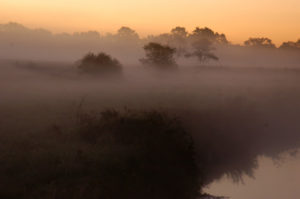 An orange sky rests upon the impenetrable white fog as dawn breaks over Holland brook on the first day of September. The predawn landscape is shrouded in a heavy mist so deep, only the treetops can be seen.
An orange sky rests upon the impenetrable white fog as dawn breaks over Holland brook on the first day of September. The predawn landscape is shrouded in a heavy mist so deep, only the treetops can be seen.
As September exhales the last warm breath of summer, it begins to inhale cool autumn air in a respiratory sequence of endless seasonal change.
With barely 9 days of autumn out of 30, the title to September is in summer’s name, despite the lien filed by fall for possession. The struggle that ensues is openly expressed in fits of alternate ownership, where autumn takes over with chilly nights while summer responds with beautiful warm days, indistinguishable from its July and August menu.
The engagement of warm summer days and cool autumn nights, in a battle for dominance, leaves the river’s flood plain covered with heavy morning mist. The impenetrable white fog hides everything except isolated tree tops to give the impression of a primordial soup that first gave rise to life on earth.
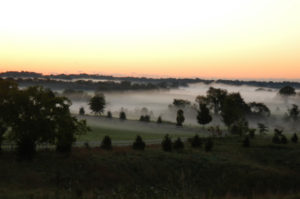
White mist rising up from the South Branch, submerges trees in a dense early morning fog, characteristic of the drastic day and night temperature changes in early fall.
As autumn appeals its case to the heavens, the sun begins to shift its position and rides lower in the sky, away from its high summer orbit. Evidence of this collusion is signaled as the dawn light colors the morning mist with every tint from gold thru orange to deep purple; a precursor to the colorful foliage that defines the fall season. The colors signal another vote for autumn’s plan to own September.
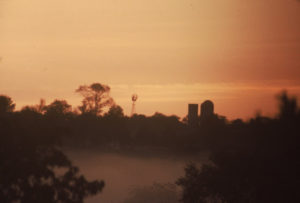
Except for the silhouette of farm building on the high ground, this scene has played out along the South Branch for thousands of years when autumn approaches.
Ultimately it is the stars in the heavens which have the final say, as they align to signal the exact moment of the autumnal equinox to find in fall’s favor. There is no chance of appeal, though summer still resists.
Offering blue skies and warm days, scraped from the bottom of it’s now empty quiver, summer attempts to keep the foliage from changing to a colorful no vote.
First to buy into autumn’s argument is Virginia creeper and poison ivy. Summer ignores their decision and counters that vines showed color back in August. A time clearly owned by summer and validated by consensus. It is when the black gum trees’ leaves began to turn a bright salmon color that summer’s brave stance began to waver. Here was a tree whose leaves began to light up the greenery like old fashioned lights tacked to the porch rail to celebrate the holiday season. Once the trees began to turn, summer knew its days were numbered.
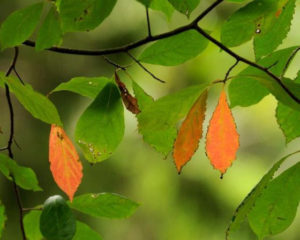
Black gum leaves mark the beginning of nature’s display of autumn color.
The stalwart oaks were the next to be counted as they sounded in favor of autumn, treating each fallen acorn as a separate vote. The deer found in favor of summer and began to eat all the fallen acorns in an attempt to cancel the oaks’ ballots. If summer was hard of hearing and the polling place rife with fraud, the oaks along with the sweet gum trees blinded the hillsides with color. Deep scarlet red oak leaves combined with a brilliant array of yellow, purple and old rose, star shaped sweet gum leaves. Norway and sugar maples chimed in with fluorescent red and yellow leaves. The final tally was overwhelming, a landslide in favor of autumn’s claim to September and an end to summer’s futile efforts to hang on.
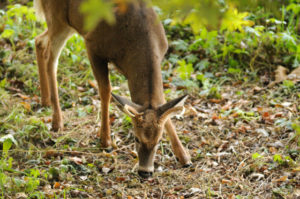
A young buck searches the ground for acorns in early September. Acorns are the number one food that deer love. when you see deer hanging around under a tree in early fall, notice that tree is more than likely an oak. Deer dine as we are supposed to, they eat what is in season.
Summer looked upon the flowers of the field to see the drooping heads and faded colors of the delicate muses it so carefully nurtured and who, in return, stood by summer’s side until their death. Summer was finally moved to surrender its claim of September to autumn. With a last warm breath, summer whispered a vow to return, even before the final days of the next spring.
Author Joe Mish has been running wild in New Jersey since childhood when he found ways to escape his mother’s watchful eyes. He continues to trek the swamps, rivers and thickets seeking to share, with the residents and visitors, all of the state’s natural beauty hidden within full view. To read more of his writing and view more of his gorgeous photographs visit Winter Bear Rising, his wordpress blog. Joe’s series “Nature on the Raritan, Hidden in Plain View” runs monthly as part of the LRWP “Voices of the Watershed” series. Writing and photos used with permission from the author.
Article and photos by Joe Mish
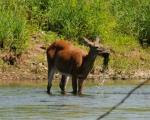

Dining at the underwater salad bar, this deer enjoys more than a mouthful of greenery, obtained by submerging its face in the water up to its ears.
August is a deep relaxing stillness in the never-ending cycle of renewable life. It is the moment after the final brush stoke is applied to an artistic masterpiece. Work that began anew, a year before, has reached a higher level of maturity in an infinite succession of seasonal effort.
The terminal end of each season can be a time of reflection, as an endpoint immediately prompts the thought of a beginning. August, however, is different, as there is an aura of timelessness created in an extended moment of satisfying exhalation; an arrival after a long journey.
Time is now suspended by desire. August is the moment we want to last. There is no desire for summer to end or feel the chill of winter sooner than scheduled. Mentally we drag our feet to slow the calendar, even assigning 31 days isn’t enough, and in response, time accelerates.
While the berries harvests of June and July have gone by, the plants that sent their energy to the fruit, now direct it to the roots and leaves in preparation for next berry season. The berry season may have been the highpoint for berry consumers but for the blackberry or dewberry plant, August is a finish line in a race to recover and maximize growth for next year’s crop.
The dark green leaves and vegetation, that dominate the high summer landscape, are noticeably different than the array of green tints seen in the spring. It is as if colors went through a maturation process independent of natural influences. Where the palest greens began to darken in color, as each successive tint accumulated, until it reached a deep forest green.
The summer greenery is not limited to plants and leaves dancing in the wind. Beneath the surface of the river, underwater grasses have reached maturity by late summer. In clear shallow water, the fast current animates long strands of flowing grasses, isolated in bundles across sections of sandy river bottom. Dark green grass sways alongside pony tails of Kelly green and gray green grass to cast a hypnotic spell on a passing paddler.
Deer relish these grasses and spend many a high summer day, faces submerged, full to their ears, in an effort to enjoy that cool mixed salad.
Blooming raspberry colored thistle, topped with flocks of hungry yellow goldfinch, teasel, goldenrod, strands of deep purple pokeweed berries and off-white Queen Anne’s lace, act as colorful bejeweled timepieces set among the greenery of August. Listen closely and you can even hear the ticking of that seasonal clock as black walnuts begin drop. The ticking is especially loud and shocking when a plum sized black walnut falls into quiet water on a calm, windless day, to spike a paddler’s heart rate.
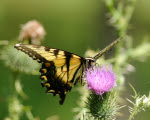
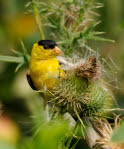
Goldfinch and tiger swallow-tail feed on the blooming thistle of late summer.
August can hardly keep a secret as it reveals a preview of things to come. Look closely and you can find isolated flashes of red and orange staghorn sumac, poison ivy and Virginia creeper. Even if you miss the visual clues, August provides an occasional chilly morning as a reminder that its moment of stillness is just an illusion.
The gold of August is revealed by its first two letters, au, the symbol for gold and awarded for achievement. The ‘gust’ or gusto represents the vigor of mature life that peaks in high summer.
Author Joe Mish has been running wild in New Jersey since childhood when he found ways to escape his mother’s watchful eyes. He continues to trek the swamps, rivers and thickets seeking to share, with the residents and visitors, all of the state’s natural beauty hidden within full view. To read more of his writing and view more of his gorgeous photographs visit Winter Bear Rising, his wordpress blog. Joe’s series “Nature on the Raritan, Hidden in Plain View” runs monthly as part of the LRWP “Voices of the Watershed” series. Writing and photos used with permission from the author.
Article and photos by Joe Mish
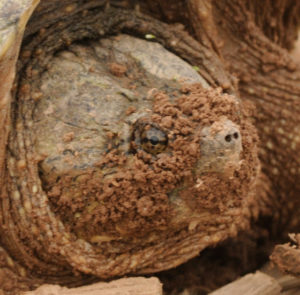
A snapping turtle mom in the process of laying eggs, remains motionless for hours, her body rising up as each egg is laid in the nest. Soil covers her face as a result of excavating a nest hole in which she will lay, according to several sources, 20 to 40 eggs.
I have always been fascinated with turtles, most likely because they were such strange animals, so different from anything else. They wore their skeleton on the outside, so in a way, they never left home even when they traveled. I learned the top shell was a carapace and the lower shell was a called a plastron. For a kid, way back when, to toss those words around, made people take notice and think the kid must be a budding genius. When asked, “what do you want to be when you grow up?” The answer was a quick, “I want to be a herpetologist!”, immediately followed by, “What’s a herpetologist?”.
A small book, A Golden Guide, Reptiles and Amphibians, was my constant companion. I studied the turtle section and noted the distribution of each species as shown in pink on a profile map of the USA. I was used to seeing painted turtles, musk turtles and snapping turtles when I went fishing, and box turtles a-plenty crossing roads on the way to the shore. There was an area in the nearby clay banks where slow flowing streams and spring fed ponds that drained into the river were overrun with spotted turtles.

A musk turtle sunning high above the water. Often when canoeing, a large splash of a musk turtle diving off a high branch causes a moment of mystery.
On occasion an uncommon turtle would cross my path. It was these rarely seen animals that really drew me in. There were wood turtles, Muhlenberg/Bog turtles and even a diamondback terrapin caught in a box style crab trap in Raritan Bay. These turtles being royalty; given their limited distribution.
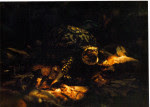
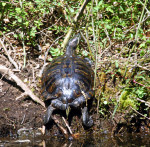
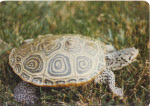
From top to bottom: A terrapin, red slider and eastern box turtles are a few of the turtle species found in NJ. Sliders and map turtles are working their way north via the Delaware Raritan canal.
As I got to know turtles and realized how long they live and how vulnerable they can be, I felt a kinship of sorts and became a guardian of these gentle creatures. When summer is about nigh, especially the first couple weeks of June, turtles are often seen crossing roads to traditional nesting grounds where the female will lay a batch of white leathery eggs in a hole she digs with her hind feet. This is when female turtles are most vulnerable to being crushed on the roadways. I stay alert to avoid adding to the carnage and will help a turtle cross a road in the direction she is headed, when I can safely do so.
Considering some females may not reach maturity for 8 to 10 years, as in the case of the wood turtle, each lost female represents a devastating blow to an already threatened species.
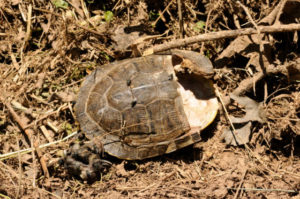
This wood turtle on her way to lay eggs was killed by a mower. Considering she was at least 10 years old the situation is even more tragic.
Turtle nests may be found hundreds of yards from any pond, river or stream. Telltale signs of a nest will be the curled fragments of the white egg cases scattered around a small hole after hatching. Otherwise you will never find a nest unless you see a turtle laying eggs or a nest dug up by a fox.
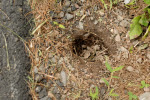
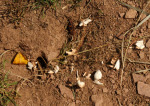
Scattered scraps of leathery turtle eggs post hatching, are often the only clue of a turtle nest. A typical turtle nest hole. This was made by a wood turtle.
I recently discovered that several map turtles have been using my yard and surrounding properties as a nesting ground. Map turtles were previously only found in southern New Jersey but have moved north primarily via the Delaware Raritan canal to the Millstone and Raritan rivers. These turtles are travelling at least 400 yards uphill through thick grass to dig nests. Imagine the journey the little guys have to survive as they follow their internal GPS back to the river.

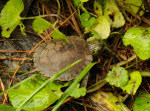
A painted turtle (top) and map turtle hatchlings make their way thru heavy grass and brush to the river.
I was fortunate to come across a snapping turtle laying eggs in a recently planted cornfield. The hours long process of laying, covering and paving over the nest by the female was captured on a GoPro camera. It is distilled down to 6 minutes and can be viewed at http://winterbearrising.wordpress.com/
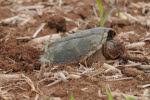
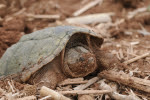
A snapping turtle lays eggs in a corn field. An hours long process where she is vulnerable to predators.
As the incubation period for most turtles can vary greatly, expect a hatch to occur from late August to September. Sometimes the hatch will not occur until the next spring. The cooler the weather during incubation period produces more males and females when weather is warmer. Across turtle species, the females reach productive maturity, in some cases, years after the males.
So be alert for nesting areas and local migrations during the nesting and hatching periods. Your yard could be a turtle nursery and you might not even know it. Be kind to our turtles and honor the legacy handed down from the Unami, a matriarchal branch of the Lenapes, known as the turtle people which inhabited this part of the state.
Author Joe Mish has been running wild in New Jersey since childhood when he found ways to escape his mother’s watchful eyes. He continues to trek the swamps, rivers and thickets seeking to share, with the residents and visitors, all of the state’s natural beauty hidden within full view. To read more of his writing and view more of his gorgeous photographs visit Winter Bear Rising, his wordpress blog. Joe’s series “Nature on the Raritan, Hidden in Plain View” runs monthly as part of the LRWP “Voices of the Watershed” series. Writing and photos used with permission from the author.
Article and photos by Joe Mish
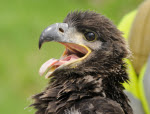
Three generations of eagles have cast their shadows over the land along the South Branch. Eagles are often seen but not recognized because the white head and tail are not developed until the 4th or 5th year.
A large dark bird perched on a light gray branch of a dead tree that hung low over the South Branch. I was quite a distance upriver, my attention focused navigating the shallow water when I caught sight of that dark, solid brown bird. Thinking it was a large hawk, I pulled the camera from the bag in the event I might get near enough for a photo. I aligned the canoe with the current when I was quite close, traded the paddle for the camera and began to click away. I drifted directly under the co-operative bird and began to wonder at the exceptionally large beak. I couldn’t imagine that after viewing the images online, I had been in the presence of a juvenile bald eagle.
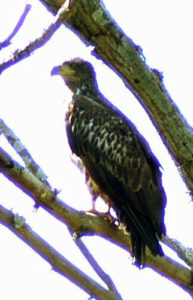
That event occurred in the spring of 2011. It was the very first time I ever saw an eagle on the South Branch and almost discounted it as an oversized, unidentified hawk.
Since 2011, I had been seeing more eagles of different age groups in that same area and in December of 2014, the first sticks were assembled into a nest. By late March 2015 eggs were being incubated and two eaglets hatched in April and banded in May with green aluminum bands E14 and E15.
Up to that point eagles had existed for most people only as a concept or an image on coin of the realm or marketed products with a patriotic flare.
The question now on eagle watcher’s minds after the 2015 success was what would happen next year? Would the eagles return? Would they use the same nest? Was the nest too close to human activity and be abandoned?
Late December 2015 a pair of adults thought to be the same eagles from the previous year, began to build a new nest opposite the old nest. It seemed quite a random decision and in human terms, spiked with a heavy dose of humor attributed to the obsessive behavior of one of the pair. they have a perfectly good nest, why are they building another?
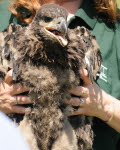
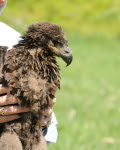
Eagles have been known to build nests and not use them, sometimes called, practice nests, as a best guess. In any event, the nest went up in record time and another pair of eagles hatched, banded and fledged in the spring of 2016. That year the eaglets were banded with green bands bearing E43 and E44.
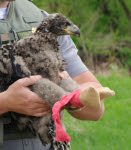
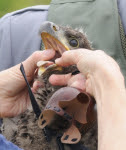
Reputed to mate for life, eagles tend to go separate ways after raising their young, often to far off destinations. One of a local pair had been tracked to Long island and the other to
Philadelphia. Given the vagaries of nature, sickness, accident and foul play it is somewhat miraculous they meet again, same time, same place, to raise another brood.
In late 2016 the eagle’s nest was destroyed and hearts sank for the production a third generation of new eagles on the South Branch.
Our eagles would not let us down as sticks began to reappear and another new nest was constructed. Speculation was ripe with concern that it was too late or the disturbance would discourage the eagles from mating and laying eggs. Right on schedule eggs were laid and two eaglets hatched in the spring of 2017. Banding took place in May and green bands E57 and E58 were affixed to the legs of a feisty pair of 2017 South Branch graduates.
Three years in a row, two eagles produced and fledged six offspring along the South Branch. In that nest they delivered three generations of eagles to someday impress the children of today’s children with the spectacular view of a wild and free eagle casting its shadow across the land.
This eagle pair has demonstrated persistence, patience, devotion and tolerance with their presence along the South Branch; Qualities that would serve all communities well to embrace.
Author’s note: See winterbearrising.wordpress.com bottom of gallery2, for age difference by plumage and a video snippet from the 2017 eagle banding.
Author Joe Mish has been running wild in New Jersey since childhood when he found ways to escape his mother’s watchful eyes. He continues to trek the swamps, rivers and thickets seeking to share, with the residents and visitors, all of the state’s natural beauty hidden within full view. To read more of his writing and view more of his gorgeous photographs visit Winter Bear Rising, his wordpress blog. Joe’s series “Nature on the Raritan, Hidden in Plain View” runs monthly as part of the LRWP “Voices of the Watershed” series. Writing and photos used with permission from the author.
Article and photo by Joe Mish
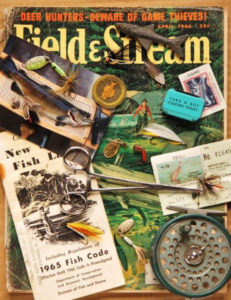
Field and Stream dreams come true on the South Branch of the Raritan. Opening day of the NJ trout season stirs memories as strong as a lifetime of Christmas morning and birthday surprises.
Right along with the anticipation of presents on Christmas morning, April and the opening day of fishing season both involved a dedicated countdown. For a month, each passing day was marked with a big X on the complimentary Esso service station calendar. It was understood, there would be no sleep on the eve of this once a year event.
Times have changed but tradition still lingers as many NJ anglers prepare for the opening of trout season in early April. One of the best places to live out a fishing fantasy is in Branchburg. As the name implies the township is bound for the most part by the North and South branches of the Raritan River, both heavily stocked with trout by the NJ Division of Fish and Wildlife.
Of course trout are not the only game in town. As the river flows from the mountains to the sea, fish can swim upstream as well as down. What that means is tiger muskies and hybrid bass can find their way downstream from Spruce Run as well as stripped bass, hickory and American shad can migrate upstream from the Atlantic Ocean. The state had been using an underwater camera to monitor quantity and species of fish in the area around the confluence of the Raritan and Millstone rivers, species you wouldn’t believe were observed. It was reported in a news article several years ago that trophy brown trout, walleyes, muskies, stripped bass, shad and several forage species were recorded. The beauty of fishing a river is you never know what you might catch.
While trout get the most press, the lower river is primarily a seasonal trout fishery with most angler activity occurring around opening day and subsequent stockings. It is considered to be ‘put and take’ fishing. There are holdover trout but you have to search for them. It is reported trout will travel distances to find suitable habitat with the water temperature being a prime factor. Each species has a preference for a specific temperature range so be sure to carry a thermometer if you want to become serious about your fishing.
The South Branch is also chock full of smallmouth bass which are a year around fish. Fish in the twenty-two inch range have been reported. Smallmouths in the twelve to fifteen inch range have a tendency to tailwalk on the surface of the water while their big brothers often stay deep and pull hard. My favorite lure for these ‘bronzebacks’ is a Panther Martin spinner with a small curly tailed grub on an ultralight fishing rod. Always have a hemostat or thumb forceps handy to remove the hook from any fish you wish to release.
Fishing methods and equipment span the spectrum of human imagination and most are effective on any given day. Expensive Orvis fly rods to lawn chairs and igloo coolers, garden worms to woolly buggers to Mepps spinners all take their share of fish. Fishing allows for as much science, superstition or tradition you might want to use in your piscatorial pursuits. There are even solunar tables which scientifically predict the best days to fish, however, everyone knows the best day to fish is whenever you get the chance.
So if your bumper sticker proclaims, “the worst day of fishing is better than the best day at work”, you already have your gear in ship shape condition and have started your countdown to the April 8th NJ trout season opener for 2017.
Author Joe Mish has been running wild in New Jersey since childhood when he found ways to escape his mother’s watchful eyes. He continues to trek the swamps, rivers and thickets seeking to share, with the residents and visitors, all of the state’s natural beauty hidden within full view. To read more of his writing and view more of his gorgeous photographs visit Winter Bear Rising, his wordpress blog. Joe’s series “Nature on the Raritan, Hidden in Plain View” runs monthly as part of the LRWP “Voices of the Watershed” series. Writing and photos used with permission from the author.
Article and photo by Joe Mish
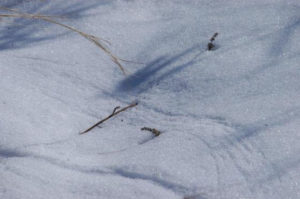
The hand of the wind uses the delicate grass to etch its thoughts in the snow. Nature’s secrets are whispered among the wooded hills and fields for all who pause to ‘listen’.
March is the month when winter puts its house in order to depart our latitude on its tour of the earth.
Remnants of left over winter wind, swept from dark, frozen nooks and crannies, are set free to blow themselves out in the twenty days leading to the arrival of spring.
The force of the wind breathes life into tree canopies and grasses as they dance and sway to the tune of the invisible but palpable energy. There is joy expressed when those, planted in place, unable to change location, experience rhythmic movement in perfect time.
A linear mass of silver maple trees, along the river’s edge, branches tipped with red velvet buds, sway in unison, as they execute a perfect ‘wave’, encouraged on by a burst of wind which leads the cheer.
Consider that the trees and tall meadow grass have evolved to take advantage of the wind. Dispersion of seed that still cling to stems and pods are sent aloft on a later flight to give the best chance for germination than seeds dispersed months earlier.
Trees benefit from the March wind as broken, insect infested branches are excised in a manner to suggest surgical intervention to remove a cancerous limb. The wind effectively prunes tree branches to allow sunlight to penetrate the canopy and promote new leaf growth; each leaf a new solar factory to boost the tree’s nutrient supply.
The wind has a wide range of expression that arises from deep internal turmoil. Perhaps the wind offended the gods in a prideful manner that justified eternal punishment. The gods therefore made the wind invisible to all the senses except for touch, and then only when the wind moves.
The wind constantly struggles with this blow to its vanity and does its best to make its presence known by channeling other elements.
Think about the wind and the scale of expression from hurricanes and tornadoes to a gentle whisper, where the wind uses a dried stem of grass or tree branch to etch its thoughts in the snow or the side of a wood building.
A spring breeze, carrying the scent of lavender blossoms, adds another dimension to the wind’s ‘visibility’ as the wind assumes the identity of the aroma. This is an expanded statement of expression; a loophole to get around the punishment imposed by the gods. This pleases the wind.
As the wind struggles to regain its physical identity and frustration builds, snow and ice are incorporated to flesh out the wind and give it a visible form.
Sometimes the desire to be seen is so fierce, the wind driven snow and ice makes the sense of sight useless, adding to the wind’s frustration, causing it to howl louder and blow harder.
The blustery wind, complement of March’s winter legacy, eventually subsides to become the gentle breeze of spring. The edge of winter passes and tempers the winds attitude to more gentle expressions of mood.
Author Joe Mish has been running wild in New Jersey since childhood when he found ways to escape his mother’s watchful eyes. He continues to trek the swamps, rivers and thickets seeking to share, with the residents and visitors, all of the state’s natural beauty hidden within full view. To read more of his writing and view more of his gorgeous photographs visit Winter Bear Rising, his wordpress blog. Joe’s series “Nature on the Raritan, Hidden in Plain View” runs monthly as part of the LRWP “Voices of the Watershed” series. Writing and photos used with permission from the author.
Article and photos by Joe Mish

A juvenile myrtle warbler searches the ice shrouded shoreline of the South Branch in late February
February is midwinter’s better half, given it is two days shorter than any other month and two days closer to spring, a virtual, ‘get out of winter free, card’. The significance of those two missing days provides a powerful psychological boost to soothe winter doldrums and seasonal affective disorder accumulating since December.
Although spring is the ‘finish line’ for surviving winter, the early days of spring are often indistinguishable from winter weather. This demonstrates that our characterization of the seasons is based more on legend than reality, especially when a lingering winter feels like an eternity.
Moving from impressionable feelings and missing days to more tangible evidence, February provides many visual clues that spring is around the corner. Its 28 days are a prelude or appetizer, stirring the emotions, building anticipation for the main event, the first day of spring.
To see visual clues we need light and light is what February delivers. In 28 short days we gain about an hour of day length, most evident to causal observers by noting the later time of sunset.
The increasing day length triggers a response in people and animals as we see the start of bird migration, courtship, flowers and tree buds.
Bird migration is one of the most colorful visual cues that winter has run its course. The milder the winter the earlier migration begins. Migration may be local, as with bluebirds or two thousand of miles away for many of the colorful warblers.
Late February usually marks the very beginnings of small bird migration north. Our rivers, streams coastlines and even interstate roadways provide linear pathways for migrating birds. The most colorful and plentiful are the myriad of warbler varieties. It is not unusual to see a bright flash of color darting along the riverside in late February despite shoreline ice and cold weather. A band of north bound travelers may find temporary shelter during a cold spell on south facing hillsides or in brush along steep river banks, protected from the wind and saturated with full sun.
Hawks are usually seen now in pairs as they bond prior to nesting. The owls hooting on cold winter nights and local bald eagles may well be incubating eggs.
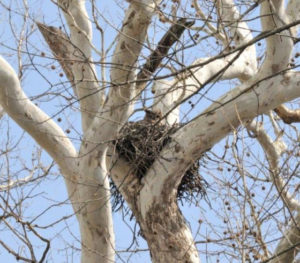
Great horned owl nesting in am old red tailed hawk nest
Muskrat, mink and fox are out and about in a courting mood. This is the time to scan fields for red fox roaming the countryside looking for mates. Love is definitely in the air.
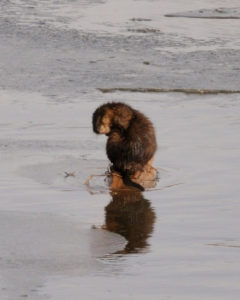
Muskrats are more often seen during their late winter early/ spring courting season
Male white-tailed deer have dropped their antlers and females are heavy with fawns as day length triggers hormonal changes to alter behavior and ensure best chances for winter survival. Now is a good time to walk the fields and woodlots to look for dropped antlers.
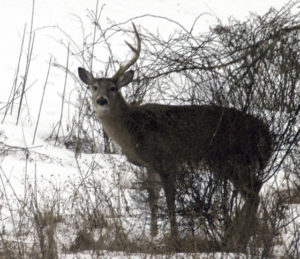
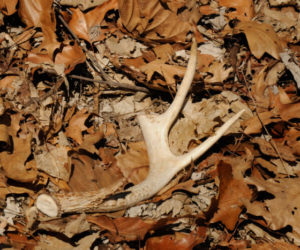
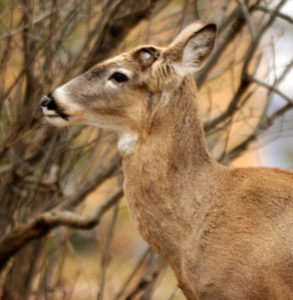
A buck has dropped one antler, the other will soon drop perhaps when it jumps a fence. A dropped antler charcterized by an irregular base. Antler buds after the antlers drop. Within a couple of months, the antlers will begin to sprout from these buds surrounded by viable tissue with a velvety appearance that readily bleeds if injured.

The first and most consistent sign of spring for me is the blooming of snowdrops, en masse on a hillside, near where I usually launch my canoe on the South Branch. As cold as it might be, the sight of those tiny white flowers gives me inspiration, fires my energy and issues a solemn promise of the return of spring.
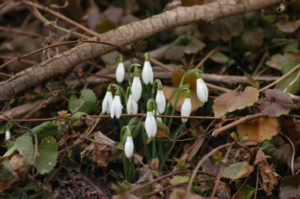
A patch of snow drops blooming midwinter heralds the return of spring
By February, the deep red leaf buds, on the trees that line the river, stand out against brown and gray interlaced branches. When viewed at a distance, the contrasting colors are enhanced as they take on a solid appearance as if created by long horizontal brush strokes in a painting.
A full moon will occur on February 11th to light up the night, as a compliment to the lengthening daylight, to make February a well lit marquee announcing next month’s arrival of spring.
Author Joe Mish has been running wild in New Jersey since childhood when he found ways to escape his mother’s watchful eyes. He continues to trek the swamps, rivers and thickets seeking to share, with the residents and visitors, all of the state’s natural beauty hidden within full view. To read more of his writing and view more of his gorgeous photographs visit Winter Bear Rising, his wordpress blog. Joe’s series “Nature on the Raritan, Hidden in Plain View” runs monthly as part of the LRWP “Voices of the Watershed” series. Writing and photos used with permission from the author.
Article and photos by Joe Mish
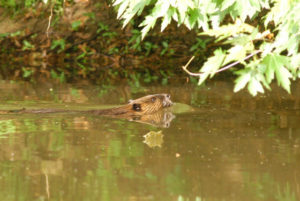
A beaver, whose existence is hidden in plain view, plies the local waters to shatter the belief the area is sanitized of wildlife typically associated with far off wilderness destinations.
As the earth turned its back to the sun on the first evening in January, the rising moon appeared as a thin silver crescent, low on the western horizon.
Just as the moon was high enough to reflect on the mirrored water of the North Branch, its perfect image was disturbed by a series of deep ripples that shattered the image into broken pieces of shimmering light.
The dark night, with minimal light reflected off the moon, made it difficult to see details, though it was clear that the disturbance was made by a beaver.
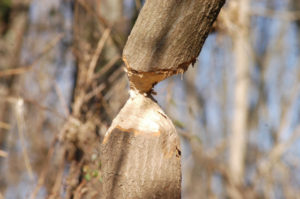
Earlier in the spring I had noticed a small tree cut down, showing unmistakable beaver sign, where a stump is gnawed evenly around, tapering to a perfect point.
For many years, beaver sign along the North and South Branch and Raritan rivers have been commonly seen in the January, February time frame. As the rivers are mostly shallow, the beaver are typically transients heading to the deeper water of the Delaware Raritan Canal or the Millstone to over winter. Many are killed by cars or trapped when they begin to fell trees across the road as was the case in Manville on the D&R canal.
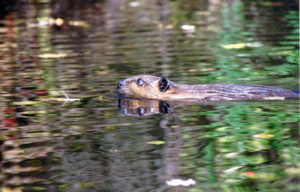
Beaver on the D&R canal built a den and felled trees across the road.
The odd thing about the freshly cut tree I saw, was that it was cut down in April. This was late in the year for a transient beaver. I kept watch all summer and saw no other sign until I noticed wide paths leading from the corn field to the river. The trail was too wide for a muskrat and too muddy for a groundhog. Apparently the beaver was feeding on corn all summer long. No sign of a den was apparent until the fall when the beaver began to cut branches and small trees, piling them at the base of exposed tree roots along a deep section of the river.
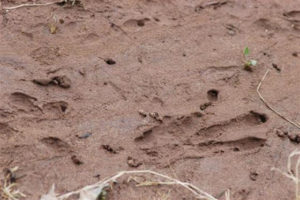
Beaver tracks in the mud along the Raritan River
It was now January, almost 3 months after the corn had been harvested and on this day the corn stubble was dusted with a light snow cover. The thin ice that formed along the banks showed a trail of bubbles made by the beaver as it traveled from its den to stockpile small branches for midwinter dining.
It was interesting to see where muskrats had been under the ice, leaving similar trails of exhaled air bubbles like the beaver, though the beaver left a trail of much larger air bubbles.
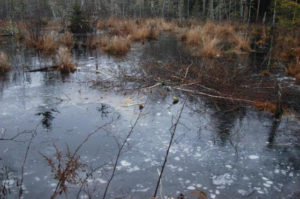
Exhale air from a beaver leaves large bubbles under the ice
Walking along the high bank and mindlessly following a set of fox tracks in the fresh snow, I saw where the beaver came ashore and went a short distance into the empty cornfield. The trail led to a vertical drop down the steep bank, which leveled off and then angled sharply to the right with a quarter turn to the left and directly into the water. It was apparent the beaver slid, rather than climbed back down into the water. A single footprint was evident where it corrected its slippery course.
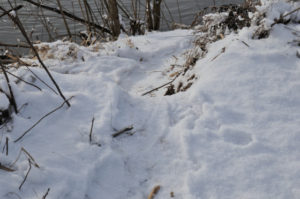
Notice the single footprint to the right side of the trail before the first drop
Further downstream across from the den there was an oak about 10 inches in diameter that the beaver had started to gnaw during the fall and abandoned in favor of several smaller trees 2 to 3 inches thick. That oak was now lying on the ground, a testament to the beaver’s determination, powerful jaws and sharp teeth. It will be interesting to see what the beaver will do with this large fallen tree.
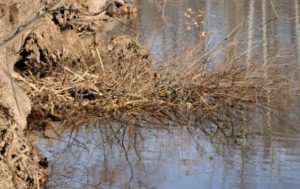
Beginnings of a beaver den or dam.
Beaver have always been associated with the wilderness, their pelts and castor glands served as motivation for French Canadian voyageurs and trappers to open the west after populations were depleted in the east.
To have beaver in our midst is a testimony to the tenacity of wildlife populations long thought erased from existence. It reminds me of Catholic school when the nuns told us to scrunch over in our seats to make room for our guardian angels. In a real sense, beaver are invisible guardian angels of our wild heritage that most people don’t believe exist and never consider.
Author Joe Mish has been running wild in New Jersey since childhood when he found ways to escape his mother’s watchful eyes. He continues to trek the swamps, rivers and thickets seeking to share, with the residents and visitors, all of the state’s natural beauty hidden within full view. To read more of his writing and view more of his gorgeous photographs visit Winter Bear Rising, his wordpress blog. Joe’s series “Nature on the Raritan, Hidden in Plain View” runs monthly as part of the LRWP “Voices of the Watershed” series. Writing and photos used with permission from the author.
Except as noted, article and photos by Joe Mish
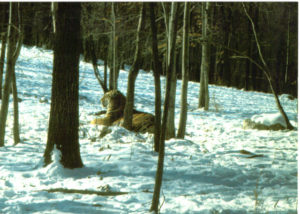
A Siberian tiger, out of place in modern times in New Jersey, comfortably rests on the frozen snow in sub zero temperatures, intensified by a strong northwest wind. Conditions that would turn exposed flesh beet red in an instant, didn’t phase this big cat as it appeared oblivious to the deadly weather; as if not bound by the laws of Nature.
It was a bitter cold day as Bert and I drove the Warner Bros Jungle Habitat trails to check on the open ranging wildlife that occupied the windswept mountains and valleys of the northern New Jersey wildlife park. Inside the warm Chevrolet truck, converted into a veterinary mobile unit, the heater was turned up high, while warm coffee steamed the windshield. Most animals escaped the polar wind hiding behind natural windbreaks and temporary shelters placed around the park.
As we drove past the tiger compound, near the highest point of the park, here was this tiger, a cat we affectionately named, ‘Bobtail’, lying down exposed to the full force of the wind. Bearing an ever present grin, for which the big cats are known, Bobtail appeared content, oblivious to the deadly arctic blast. He remained motionless and stared into the brutal wind that must have escaped from the 10th circle of Dante’s frozen hell, showing no signs of discomfort. He may as well have been enjoying a cool breeze on a warm summer’s day.
This image of Bobtail lying in the snow captures for me the essence of the tiger. Well documented accounts of tigers hunting humans in India, and their magical ability to make kill after kill and avoid inescapable traps, have elevated the tiger to supernatural status.
This is an animal believed to exist in the spirit world as a cunning killer with the ability to transform into flesh and bone and back again at will. The tiger has a reputation of defying natural law that limits all other living things; Bobtail was doing nothing to dispel that myth on this cold day.
The poem, “Tyger”, by William Blake, written in 1794, so well captures the visceral reaction I had to the tigers, I memorized the poem. Here are a few lines that chill my blood.
In what distant deeps or skies Burnt the fire of thine eyes?
And what shoulder, & what art. Could twist the sinews of thy heart?
While here is photographic proof of a tiger living in New Jersey, an anomaly for sure, it is not hard to imagine a time when big cats stalked our land. I wondered every time I passed the tiger compound, how humans ever survived these Paleolithic predators. Perhaps it was the predators’ evolved intelligence that raised the level of human creativity in a Darwinian dance played to a deadly tune.
Evidence of saber tooth cats and jaguars, among other prehistoric creatures, were found in a limestone cave in southeastern PA near Pottstown and trace back to the cretaceous period about 100 to 66 million years ago. The cave was located in a now forgotten town named Port Kennedy, which is part of Valley Forge National Park.
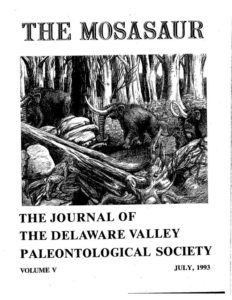
Evidence of sabre-tooth cats of the late cretaceous period discussed in this 1993 article. Additionally fossil remains have been found in the Cutter Clay works near Raritan Bay and along the shore across Raritan Bay in Union Beach.
NJ was unrecognizable in terms of geography and climate with glaciers terminating at the Watchung Mountains and our rivers not yet formed. The Hudson River at one time was thought to have emptied into the lower Raritan watershed at Bound Brook.
As the sea level rose and fell over the eons, it formed clay banks along the Raritan and its bay where dinosaur fossils and tracks have been found. To date, I am not aware of any prehistoric cat trackways or fossils being discovered in NJ. Though surely, when southern NJ was above water, it would be reasonable to expect prehistoric cats, whose remains were found in the Port Kennedy Cave, to have roamed our land.
In more modern times the eastern mountain lion did stalk the shores of the Raritan and in fact a bounty was offered and the last local cat killed in the Sourland Mountains in the early 19th century. Officially, the last New Jersey mountain lions were killed in the southern most counties about that same time.
Rumors of mountain lions persist in several north east states, though no hard evidence has been uncovered in NJ. Given the fact that people have been known to illegally harbor large cats in less than secure enclosures, anything is possible.
Today, New Jersey has a healthy population of bobcats, primarily in the northwest part of the state. The retreating glaciers left a boulder strewn, mountainous landscape with plenty of nooks and crannies, ideal habitat for these elusive felines. Occasionally bobcats are captured on hunters’ trail cameras to give us evidence of their presence as they are rarely ever seen even where they are plentiful.
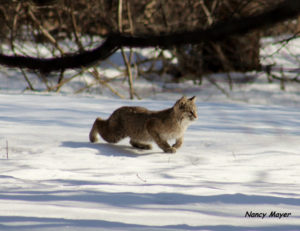
This very rare photo of a bobcat was taken in Warren County, NJ. New Jersey has a healthy bobcat population along with other wildlife thought not to exist within our borders. This cat is really a sabre-tooth tiger distilled down to miniature with all the accumulated intelligence and instincts required for survival in any geologic iteration of New Jersey. Photo by Nancy Mayer
Still the thought of saber-tooth cats, tigers and jaguars ranging across the state becomes more than just imaginary when you see the gleam in your pet cat’s eye. It is as if the prehistoric felines have been distilled down to their essence in the form of modern day cats that dominate many of our homes.
“The Man-Eaters of Kumaon”, by Col Jim Corbett, published in 1944, deals with the man eating tigers of India in the early 20th century. Please read the last chapter, “Just Tigers” before you begin the book as it puts the tiger in perspective and talks about photography vs hunting and concern for their the conservation even at that time. The first hand account of the almost supernatural ability of tigers to avoid being killed or captured while hunting humans, reveals an intellectual battle where man doesn’t always dominate nature.
THE TYGER
By William Blake
Tyger! Tyger! burning bright In the forests of the night, What immortal hand or eye Could frame thy fearful symmetry?
In what distant deeps or skies Burnt the fire of thine eyes? On what wings dare he aspire? What the hand dare sieze the fire?
And what shoulder, & what art. Could twist the sinews of thy heart? And when thy heart began to beat, What dread hand? & what dread feet?
What the hammer? what the chain? In what furnace was thy brain? What the anvil? what dread grasp Dare its deadly terrors clasp?
When the stars threw down their spears, And watered heaven with their tears, Did he smile his work to see? Did he who made the Lamb make thee?
Tyger! Tyger! burning bright In the forests of the night, What immortal hand or eye Dare frame thy fearful symmetry?
1794
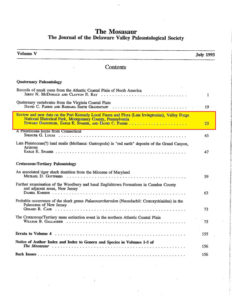
Author Joe Mish has been running wild in New Jersey since childhood when he found ways to escape his mother’s watchful eyes. He continues to trek the swamps, rivers and thickets seeking to share, with the residents and visitors, all of the state’s natural beauty hidden within full view. To read more of his writing and view more of his gorgeous photographs visit Winter Bear Rising, his wordpress blog. Joe’s series “Nature on the Raritan, Hidden in Plain View” runs monthly as part of the LRWP “Voices of the Watershed” series. Writing and photos used with permission from the author.
Article and photos by Joe Mish
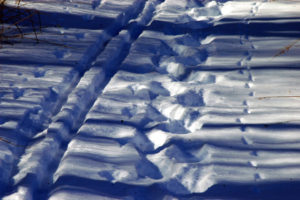
The hiker skier and the fox
passed this way on a snowy walk
The same path was taken on that day
Though each saw things a different way
Dawn was hardly accomplished when the charcoal sky, stirred by a strong cold wind, began to hurl sharp ice crystals against the dry fallen leaves. The High velocity ice pellets struck the forest floor to reverberate against the dry leaves and create a mesmerizing steady hum.
The expansive old woods, now under siege by the late November weather, had a logging road cut through it sometime in the past that now resembled a linear scar threading through the trees. The thick canopy of branches blocked the sunlight to prevent the cut from healing and provided an unobstructed view and silent pathway, for at least a hundred yards. Any bird or animal travelling across the woodlot could be easily seen.
From my vantage point, where the road curved around a large boulder to the straightaway before me, I paused to take in the view. The falling ice began to accumulate; it was like watching an invisible hand weave a white rug on a rough umber tinted latticework. The ice would take turns with large snowflakes as this tandem team laid down white pavement on the road. The thick canopy of branches in the surrounding woods prevented much of the falling snow from reaching the ground. The white flakes and ice crystals that fell here resembled a light scattering of powdered sugar that stood in stark contrast to the near solid white woods road.
The woods are transformed with a light snow as hidden pathways and game trails show up as white lines and the thick woods instantly fitted with clear windows into the woodland depths. Any animal previously hidden by the labyrinth of branches in the one dimensional muted background of similar color, now are exposed as dark forms against white as they pass through these previously invisible portals. The slightest movement, even at a distance, now betrays an animal’s presence as sound becomes an irrelevant turncoat.
Feeling chilled, I was about to resume my walk when a quick movement in the woods caught my eye. Like watching a silent movie in black and white, a woodland drama was about to unfold.
Some small, fast animal was running along the ground in a straight line, on a course that would take it across the woody lane. In short order it appeared in the open and I was still questioning its identity. I could now see this was clearly a bird as it looked like a pigeon, though slightly larger. It was so odd to see a bird running instead of flying and given its speed, its health did not seem compromised. The fleet footed bird was a ruffed grouse! I recalled seeing grouse feeding in the predawn light on other occasions and thinking how they resembled pigeons.
In less than 15 seconds, another larger form appeared and was clearly running along the same track as the grouse. This was a red fox!
The fox had probably gotten a glimpse of the grouse, lost sight of the bird, then picked up its scent to begin the chase. The grouse felt confident enough it could escape on the ground as the fox was in steady but lagging pursuit.
The bird would take to the air if the fox came within striking distance and barring intervention from a hungry cooper’s hawk, the grouse would enjoy the rest of the day in peace. The fox was on a foolish pursuit chasing an alert grouse. Its hunger in full argument with its experience arrived at a compromise and the chase began in deference to hunger.
I waited another few minutes and couldn’t resist trying to call the fox in. Like magic the fox came running, sat at the edge of the lane in the white snow and stared in my direction for a good minute, stood up and trotted off.
As the fox disappeared in the distant woods I again began to walk down the canopied lane enjoying the snowy woods.
The old logging road weaving through the trees scattered with snow brought the lines from poet Robert Frost to life. From “A road not taken”:
“… and looked down one (road) as far as I could, to where it bent into the overgrowth”.
Then the line from Stopping by the woods on a snowy evening:
“…to watch his woods fill with snow”……
“The only other sound’s the sweep
Of easy wind and downy flake.”
Unwrap the gift of a light November snow and enjoy sights and sounds that have inspired the verse of American Poets.
Author Joe Mish has been running wild in New Jersey since childhood when he found ways to escape his mother’s watchful eyes. He continues to trek the swamps, rivers and thickets seeking to share, with the residents and visitors, all of the state’s natural beauty hidden within full view. To read more of his writing and view more of his gorgeous photographs visit Winter Bear Rising, his wordpress blog. Joe’s series “Nature on the Raritan, Hidden in Plain View” runs monthly as part of the LRWP “Voices of the Watershed” series. Writing and photos used with permission from the author.
 An orange sky rests upon the impenetrable white fog as dawn breaks over Holland brook on the first day of September. The predawn landscape is shrouded in a heavy mist so deep, only the treetops can be seen.
An orange sky rests upon the impenetrable white fog as dawn breaks over Holland brook on the first day of September. The predawn landscape is shrouded in a heavy mist so deep, only the treetops can be seen.















































